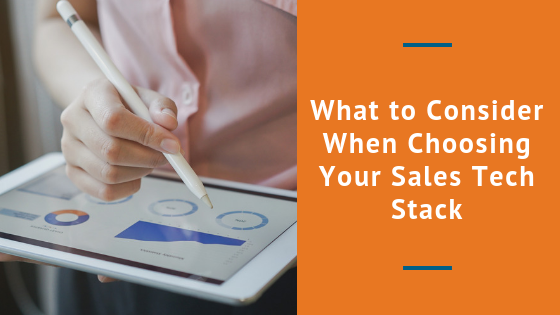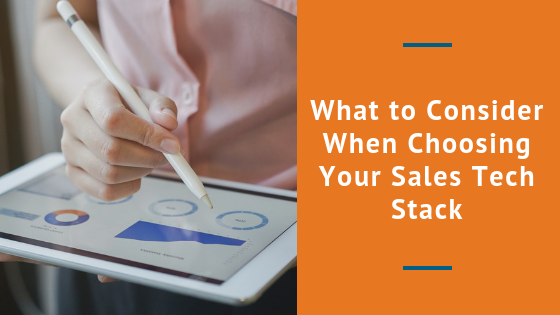
Your expertise is in selling B2B technology to companies that are seeking to improve operations, smooth out their workflows, and generally power new strategies for success. But how do you use technology as part of your SMB sales strategy? Does your sales tech stack stack up and give you access to the data, insights, and analytics you need to unlock efficiencies and increase sales volume?
We want to offer some insights into the key components of an effective sales tech stack, as well as some considerations for segmenting your sales tech to reduce costs and improve efficiency.
The Evolution of the Sales Tech Stack
As in other markets, technology has revolutionized SMB sales. Let’s consider just a few of the advances that are shaping how we sell B2B technology today:
- Bigger and better customer relationship management (CRM) technology is making it easier to store and share data. Implementing CRM in the cloud, for example, makes it easier to scale and add new CRM features and functions without disrupting sales team operations, and makes customer data accessible from anywhere. It also increases productivity. Sixty-five percent of SMB sales reps who have adopted mobile CRM solutions hit their quota, as opposed to only 22 percent of those who have not.
- Cloud computing also simplifies data management and enables big data analytics. This means that sales reps can do a better job by collecting, analyzing, and applying data. To facilitate prospecting, big data can uncover new prospects that are already in your CRM database, and match the criteria of your best customers. Using big data for predictive analysis also improves forecasting accuracy. And data maintenance in the cloud is easier, so you have more accurate customer information—B2B sales reps waste 27.3 percent of their time as a result of bad or incomplete customer data.
- Automation and machine learning are simplifying the sales process. For example, did you know that 64.8 percent of a sales rep’s time is spent on activities not directly related to sales? Prospect outreach processes such as emails, follow-up, call logs, and other steps can be automated, freeing up sales reps’ time for more important tasks. Lead prioritization can be streamlined with automated scoring powered by artificial intelligence. Many of the routine tasks of SMB sales can be automated to make sales reps more efficient and more successful.
Choosing the Right Stack Components
The right sales technology stack can transform your SMB sales teams into superstars if you understand how to match the right components to the right features so you can optimize your sales processes. When selecting the right sales technology stack for your SMB sales team, here are a few things to consider:
- Prospecting and lead qualification: Sales prospecting is one of the most time-consuming aspects of sales, and doesn’t even involve active selling. It is a precursor to sales. At the same time, 42 percent of sales reps say prospecting is the part of their job that they struggle with most. Your sales tech stack needs to have strong tools that automate prospecting and lead qualification, so that sales reps can focus on their main objective: selling. You can automate prospecting with a variety of tools, including list building, email outreach, and lead prioritization.
- CRM: Having the right CRM software improves productivity, according to 50 percent of SMB sales reps. A LinkedIn study reveals that 34.6 percent of companies believe their CRM tools are “impactful” or “very impactful” in making the sale. For most sales groups, the CRM platform is the focal point of the sales technology stack. In choosing the right CRM, you have to consider what works best for your industry, how it integrates with other systems, and whether you can extract the data you need easily, for both selling and reporting.
- Integration: In building your technology stack, you need to choose technology solutions that play well together. You want to make sure your CRM solution interoperates with business applications such as Office 365 and other email service providers. You want to be sure you can easily extract other data for analytics and reporting. You also want to be able to integrate with marketing solutions such as email campaigns and web prospecting tools.
- Measuring results: In addition to powering the sales process, your sales tech stack needs to provide insights that increase sales effectiveness. You need to be able to extract meaningful, accurate performance metrics that can help you isolate bottlenecks and flaws in your workflow. You also need to be able to generate reports that are accurate and consistent for performance monitoring and forecasting.
- Easy to use: No matter how you implement your sales technology stack, it has to be easy to use, as well as useful. Technology should be a benefit, not an impediment. If using the tools or maintaining accurate data becomes too difficult because of the time required for data entry, the sales stack will actually slow efficiency. In order for every aspect of the stack to run smoothly, it has to be chosen for ease of use, as well as its contribution to the sales process.
These are some of the criteria that go into building an effective sales stack. The process of creating your own sales tech stack can be time-consuming, and there is an element of risk—if you choose the wrong component, it becomes a weak link in the chain that affects the entire sales process.
Outsourcing Sales Tech
Of course, you don’t have to build your sales tech stack from scratch. In fact, more organizations are outsourcing qualification, lead generation, and other aspects of sales so that they don’t have to build and maintain their own sales tech stack.
Sales technology is designed to streamline sales processes, which means it should operate behind the scenes, or even offsite. With cloud computing, it’s easy for organizations to share data and integrate business processes, so outsourcing lead generation and prospecting is extremely cost-effective; you get the benefit of automating and integrating an important part of your sales tech stack through a third party, without having to manage additional personnel, overhead, or software. And the data can be readily shared through the cloud.
Applying your sales tools should not impede the actual sales process. The more you can automate via the sales tech stack, the more efficient your sales process will be. And the more sales tech resources you can outsource, the more time your SMB sales reps will have for doing what they’re good at—selling!








